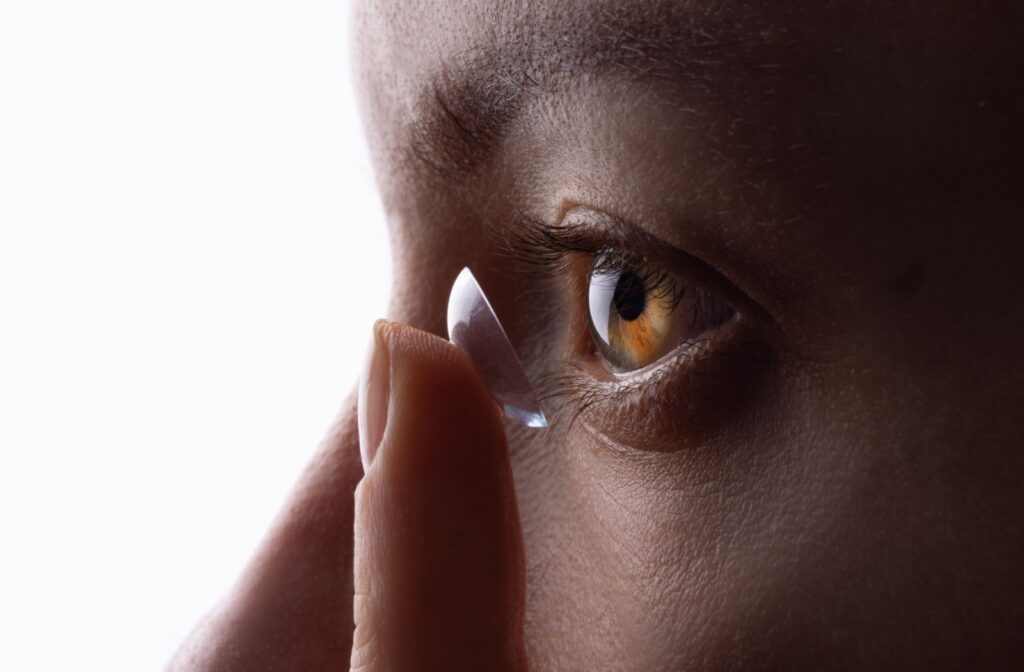Wearing a contact lens in only one eye might seem unusual, but it’s more common than you think. In certain cases, like monovision correction or when one eye has significantly different vision needs, it can be a safe and effective option. However, doing it without professional guidance may lead to problems like eye strain, discomfort, and visual imbalance.
In this blog, we’ll break down when it’s okay to wear just one contact lens, why doing so without a proper fitting can be risky, and what to watch out for if you’re considering this approach.
Why Would Someone Wear Only One Contact Lens?
There are a few situations where someone may be prescribed just one contact lens:
1. Monovision Correction
Monovision is a common technique for managing presbyopia (age-related difficulty seeing up close). In this case, one eye is corrected for distance vision and the other for near vision. Typically, a contact lens is worn in just one eye to allow this balance. While it may take time for your brain to adapt, many people find monovision a practical alternative to reading glasses or bifocal contacts.
2. Unequal Prescriptions
Some people have good vision in one eye and a significant prescription in the other. If the vision in one eye is sharp enough without correction, an optometrist might recommend wearing a lens in only the eye that needs it.
3. Post-Surgical Vision Correction
If someone has had LASIK or cataract surgery in one eye, they might only need a contact lens in the untreated eye to balance vision. This is another case where wearing a single contact can be part of a personalized vision plan.
When It’s a Problem: Risks of Wearing One Contact Without Guidance
Wearing a contact lens in just one eye without a professional evaluation can lead to several problems, especially if you’re doing it to save money or experimenting on your own.
1. Eye Strain & Headaches
Wearing one lens without proper balance can strain your eyes and brain as they try to compensate for the vision difference. This can very easily lead to headaches, fatigue, and difficulty focusing.
2. Depth Perception & Balance Issues
Our eyes work together to give us depth perception and spatial awareness. Disrupting this balance by wearing a contact lens in one eye may affect your ability to judge distances accurately—potentially making driving or certain tasks more hazardous.
3. Discomfort & Dryness
Improper fit or extended wear of a single contact lens may cause discomfort, dryness, or irritation in the lens-wearing eye, especially if the lens type or solution isn’t well-suited to your needs.
4. Long-Term Vision Problems
Over time, relying on one corrected eye can place undue strain on the other, leading to worsening vision or difficulty adjusting to future prescriptions. This is especially true if one eye is consistently overused.
FAQs About Wearing One Contact Lens
Can I wear a contact in one eye if I lost the other lens?
It’s best to avoid this. If you temporarily lose a lens, wearing just one can cause eye strain and blurry or unbalanced vision. Use glasses as a backup until you replace the missing contact.
Can I drive with one contact lens in?
Driving with one contact lens is probably not safe, especially if it results in uncorrected blurry vision or poor depth perception. It’s crucial to meet the legal visual acuity requirements for your state, and that usually means clear vision in both eyes.
Will wearing one contact lens damage my eyes?
Not necessarily, but it can cause discomfort or visual issues if not professionally prescribed. It’s important to follow your optometrist’s recommendations and attend regular follow-ups.
What if I only need correction in one eye?
If your optometrist determines that your other eye doesn’t need correction, then yes it’s fine to wear just one contact. The key is that this decision should be based on a proper eye exam.
Can I get a contact lens prescription for one eye only?
Yes. Eye care professionals often write prescriptions for just one eye when it’s appropriate. This ensures the lens fits well and suits your unique visual needs.

The Importance of a Professional Fitting
Whether you wear one contact lens or two, a proper fitting is essential. Contact lenses sit directly on the surface of your eye, so they must match your eye’s curvature, size, and prescription. Wearing an ill-fitting lens can lead to dry eye, corneal abrasions, and even infections.
A professional fitting will also take into account how your eyes work together. Even if you think you only need one lens, your optometrist may discover subtle vision issues that could be improved with a different correction strategy.
Schedule a Contact Lens Fitting in LA
Wearing a contact lens in just one eye isn’t necessarily bad, as long as it’s prescribed and monitored by a professional. Monovision, unequal prescriptions, or surgical corrections can make one-lens wear a practical option for some people. But self-prescribing or doing it to cut corners could result in discomfort, headaches, or long-term vision imbalance.
If you’re currently wearing one contact or thinking about it, the best thing you can do is schedule an eye exam to confirm it’s safe for your eyes and lifestyle.
At Total Vision Little Tokyo in Los Angeles, our experienced optometrists are here to help you make the right choices for your vision. Contact us today to schedule your comprehensive eye exam and get a contact lens plan tailored just for you.



